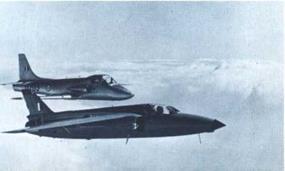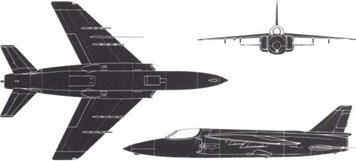Hawker Siddeley Gnat/HAL Ajeet
Fo 141 Gnat F.1, HAL Gnat and Ajeet, Hawker Siddeley Gnat T.1
Origin: Folland Aircraft (now British Aerospace), UK: Ajeet, Hindustan Aerospace Ltd, India.
Type: (Gnat 1 and Ajeet) single-seat fighter: (Gnat T.1) advanced trainer. Engine: (Gnat 1) 4.520lb (2050kg) thrust Rolls-Royce (previously Bristol, then Bristol Siddeley) Orpheus 701 single-shaft turbojet: (Gnat ll/Ajeet) 4.670lb (2118kg) HAL-built Orpheus 701E: Gnat T.1, 4.230lb (1920kg) Orpheus 101.
Dimensions: Span (1) 22ft 2in (6-75m); (Ajeet) 22ft 1 in (6 73m), (T.1) 24ft (7-32m): length (1) 29ft 9in (9 06m), (Ajeet) 29ft 8in (9 04m), (T.1) 31ft 9in (9 65m): height (1, Ajeet) 8ft 10in (2-69m). (T.1) 10ft 6in (3-2m). Weights: Empty, (1, Ajeet) typically 4.850lb (2200kg): (T.1) 5,6131b (2546kg): loaded (1, Ajeet, clean) 6,650lb (3016kg): (1, Ajeet, with external stores) 8,885lb (4030kg): (T.1, clean) 8.250lb (3742kg): (T.1. maximum) 9,350lb (4240kg).
Performance: Maximum spee_, (F.1) 714mph (1150km/h): (T.1) 636mph (1026km/h): initial climb, (F.1) 20,000ft (6096m)/min: (T.1) 9,850ft (3000m)/min; service ceiling, (F.1) over 50,000ft (15,250m): (T.1) 48,000ft (14,600m): range, all versions, maximum fuel, 1,180 miles (1900km).
Armament: (F.1, Ajeet) two 30mm Aden cannon, each with 115 rounds: four underwing hardpoints for 1,1001b (454kg) total load. (T.1) no guns, but same underwing load.
History: First flight (Fo 139 Midge) 11 August 1954: (Fo 141 Gnat) 18 July 1955: (T.1) 31 August 1959: (HAL Gnat) 18 November 1959: final delivery (HAL) early 1973: Ajeet, continuing.
Users: Finland (not operational’, India, UK (T.1).
Development: British designer Teddy Better planned the Gnat to reverse the trend towards larger and more complex combat aircraft, considering a simple lightweight fighter would offer equal performance at much lower cost. Folland Aircraft built the low-powered (1,6401b Viper) Midge as a private venture and eventually gained an order for a development batch of six, the first of which flew in May 1 956. India signed a licence agreement in September 1956 and by early 1973 had built 213 at Hindustan Aerospace (HAL) at Bangalore, as well as receiving 25 Mk 1 Gnats and 25 sets of parts from Folland. HAL also built the Orpheus engine. Finland bought 1 2, three having a three-camera nose for FR duties, and two were supplied to
Below: The first true HAL Ajeet pictured in formation with a Kiran Mk 1 on a visit to Britain in 1975.
|
|
|
|
Above: Three-view of the Ajeet, showing four stores pylons.
Jugoslavia. The Gna! was modified into a trainer for the RAF. with tandem cockpits, later wing and many other changes and 105 were supplied by Hawker Siddeley (into which Folland was absorbed) in 1962-65. Smokemaking Gnat T.1s equip the Red Arrows aerobatic team. In 1969 HAL began to study an improved Gnat which was finally agreed in 1974. Named Gnat II or Ajeet (Unconquerable), it has integral-tank wings housing the same quantity of fuel as was formerly carried in underwing tanks, thus allowing full weapon load to be carried for undiminished range: it also has improved avionics and many minor changes. HAL Gnats are progressively being brought up to this standard. In prolonged combat duty the HAL Gnats have acquitted themselves well and proved most effective in close combat.
Below: Nose of a Gnat on the flight line at HAL’s Bangalore factory. The fuel in the drop tank is carried inside the Ajeet wing.












